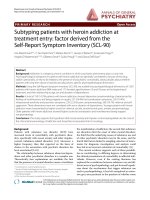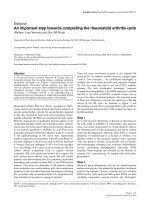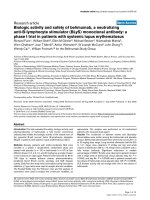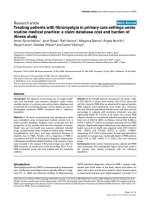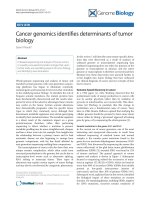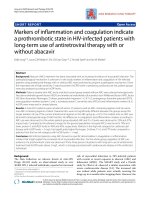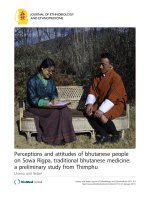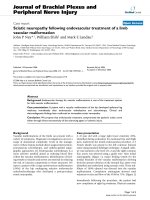Báo cáo y học: "Cancer patients'''' attitudes towards Chinese medicine: a Hong Kong survey" potx
Bạn đang xem bản rút gọn của tài liệu. Xem và tải ngay bản đầy đủ của tài liệu tại đây (227.29 KB, 8 trang )
BioMed Central
Page 1 of 8
(page number not for citation purposes)
Chinese Medicine
Open Access
Research
Cancer patients' attitudes towards Chinese medicine: a Hong Kong
survey
Yuen-chi Lam
1
, Chung-wah Cheng
1
, Heng Peng
2
, Chun-key Law
3
,
Xianzhang Huang
1
and Zhaoxiang Bian*
1
Address:
1
School of Chinese Medicine, Hong Kong Baptist University, Hong Kong SAR, China,
2
Department of Mathematics, Hong Kong Baptist
University, Hong Kong SAR, China and
3
Department of Clinical Oncology, Queen Elizabeth Hospital, Hong Kong SAR, China
Email: Yuen-chi Lam - ; Chung-wah Cheng - ; Heng Peng - ;
Chun-key Law - ; Xianzhang Huang - ; Zhaoxiang Bian* -
* Corresponding author
Abstract
Background: This article reports a survey conducted in Hong Kong on the cancer patients'
attitudes towards Chinese medicine treatment.
Methods: Cancer patients from three Chinese medicine clinics and one oncology clinic were
interviewed with a structured questionnaire.
Results: Of a total of 786 participants included in the study, 42.9% used Western medicine only;
57.1% used at least one form of Chinese medicine; 5 participants used Chinese medicine only; and
56.5% used Chinese medicine before/during/after Western medicine treatment. Commonly used
Western medicine and Chinese medicine treatments included chemotherapy (63.7%), radiotherapy
(62.0%), surgery (57.6%), Chinese herbal medicine (53.9%) and Chinese dietary therapy (9.5%).
Participants receiving chemotherapy used Chinese medicine (63.3%) more than those receiving any
other Western medicine treatments. Spearman correlation coefficients showed that the selection
of Chinese medicine was associated with the cancer type (r
s
= -1.36; P < 0.001), stage (r
s
= 0.178;
P < 0.001), duration (r
s
= -0.074; P = 0.037), whether receiving chemotherapy (r
s
= 0.165; P < 0.001)
and palliative therapy (r
s
= 0.087; P = 0.015). Nearly two-thirds of the participants (N = 274) did
not tell their physicians about using Chinese medicine. Over two-thirds of all participants (68.2%)
believed that integrated Chinese and Western medicine was effective.
Conclusion: Chinese medicine is commonly used among Hong Kong cancer patients. The
interviewed cancer patients in Hong Kong considered integrative Chinese and Western medicine
is an effective cancer treatment.
Background
Cancer is a major disease in Hong Kong with great social
and economic burden. According to the Hong Kong Can-
cer Registry, 23,750 new cancer cases and 12,093 cancer
deaths were recorded in 2006. New cancer cases in Hong
Kong has been rising at a annual rate of 2% [1]. While sur-
gery, radiotherapy and chemotherapy remained to be con-
ventional cancer treatments, 80% of the cancer patients
around the world consult complementary and alternative
medicine (CAM) for more treatment options [2-5]. Chi-
Published: 30 December 2009
Chinese Medicine 2009, 4:25 doi:10.1186/1749-8546-4-25
Received: 19 March 2009
Accepted: 30 December 2009
This article is available from: />© 2009 Lam et al; licensee BioMed Central Ltd.
This is an Open Access article distributed under the terms of the Creative Commons Attribution License ( />),
which permits unrestricted use, distribution, and reproduction in any medium, provided the original work is properly cited.
Chinese Medicine 2009, 4:25 />Page 2 of 8
(page number not for citation purposes)
nese medicine, one of the most popular CAMs, is an avail-
able option in many cancer centres in Asia [6-8], North
America [9,10], and Europe [5].
Chinese medicine and Western medicine differ funda-
mentally in their etiological concepts and therapeutic
approaches. In Western medicine, cancer is perceived as
uncontrolled growth of malignant cells which may be
treated by surgery, chemotherapy, and radiotherapy [11].
According to Chinese medicine theory, cancer is the man-
ifestation of a qi disturbance which may be treated by
mobilizing qi. Study results support the use of Chinese
medicine to treat liver cancer and leukaemia [12,13], and
recent meta-analyses demonstrated that Chinese medi-
cine improved tumor response to chemotherapy as well as
patient's survival rates [14,15]. Five common Chinese
medicine modalities, namely Chinese herbal medicine,
acupuncture and moxibustion, therapeutic massage,
qigong and Chinese dietary therapy have been used to treat
cancer [16]. Moreover, acupuncture relieves pain and
acute vomiting during conventional cancer treatment
[15,17]
While some researchers suggest that Chinese medicine
should be integrated into a comprehensive cancer treat-
ment scheme [18], cancer patients' attitude towards Chi-
nese medicine is largely unknown. The present study
aimed to reveal the prevalence and pattern of the use of
Chinese medicine among cancer patients in Hong Kong
and to assess their attitudes and intentions about such
use.
Methods
Participants
This study was approved by the Committee on the Use of
Human and Animal Subjects in Teaching and Research of
the Hong Kong Baptist University (HKBU) and the
Research Ethics Committee of the Hospital Authority
(HA) Hong Kong. Between April 2008 and August 2008,
all cancer patients attending any of the three HKBU Chi-
nese medicine clinics and the outpatient clinics of the
Department of Clinical Oncology in Queen Elizabeth
Hospital (QEH) were invited to participate in this cross-
sectional survey.
Oral informed consent was obtained from cancer patients
before participation. Each participant completed a ques-
tionnaire, which was then checked by one of the authors
(YCL). Completed and checked questionnaires were
coded to mask patients' identities. Another author (CWC)
double-checked the collected questionnaire to ensure
good quality.
In this paper, Chinese medicine user is defined as the per-
son who receives treatments of Chinese herbal medicine,
acupuncture and moxibustion, therapeutic massage,
qigong, Chinese dietary therapy and/or other therapies
that are based on the theory of Chinese medicine.
Table 1: Demographic characteristics of the study population
Variables No. of patients
n(%)
Western medicine
n(%)
Chinese medicine n(%) P-value
Total 786(100.0) 337(42.9) 449(57.1)
Age, years 0.061
Ϲ40 92(11.7) 45(13.4) 47(10.5)
41-50 218(27.7) 78(23.1) 140(31.2)
51-60 219(27.9) 94(27.9) 125(27.8)
м61 257(32.7) 120(35.6) 135(30.5)
Gender 0.285
Male 339(43.1) 138(40.9) 201(44.8)
Female 447(56.9) 199(59.1) 248(55.2)
Clinical setting < 0.001
Chinese medicine Clinic 117(14.9) 2(0.6) 115(25.6)
Western medicine Clinic 669(85.1) 335(99.4) 334(74.4)
Marital status 0.200
Married 659(83.8) 276(81.9) 383(85.3)
Unmarried 127(16.2) 61(18.1) 66(14.7)
Education level 0.001
Elementary school 244(31.0) 120(35.6) 124(27.6)
High school 374(47.6) 155(46.0) 219(48.8)
College or University 114(14.5) 33(9.8) 81(18.0)
Other 54(6.9) 29(8.6) 25(5.6)
Data are presented as the actual number of patients (percentage in that group). Chi-square tests were conducted between Western medicine and
Chinese medicine users.
Chinese Medicine 2009, 4:25 />Page 3 of 8
(page number not for citation purposes)
Table 2: Clinical characteristics of study population
Variables No. of patients
n(%)
Western medicine
n(%)
Chinese medicine n(%) P-value
Total 786(100.0) 337(42.9) 449(57.1)
Cancer type < 0.001
Lung 145(18.4) 46(13.6) 99(22.0)
Breast 128(16.3) 50(14.8) 78(17.4)
Prostate 22(2.8) 11(3.3) 11(2.4)
Colorectal 114(14.5) 53(15.7) 61(13.6)
Liver 13(1.7) 1(0.3) 12(2.7)
Stomach 15(1.9) 4(1.2) 11(2.4)
Nasopharyngeal 117(14.9) 45(13.4) 72(16.0)
Cervical 17(2.2) 12(3.6) 5(1.1)
Endometrial 23(2.9) 13(3.9) 10(2.2)
Ovary 18(2.3) 12(3.6) 6(1.3)
Other 174(22.1) 90(26.7) 84(18.7)
Stage (TNM) < 0.001
0-I 106(13.5) 56(16.6) 50(11.1)
II 122(15.5) 49(14.5) 73(16.3)
III 202(25.7) 71(21.1) 131(29.2)
IV 116(14.8) 35(10.4) 81(18.0)
Unknown 240(30.5) 126(37.5) 114(25.4)
Time since diagnosis (months) 0.005
Ϲ36 537(68.3) 216(64.1) 321(71.5)
>36, Ϲ48 59(7.5) 23(6.8) 36(8.0)
>48, <60 27(3.4) 9(2.7) 18(4.0)
м60 153(19.5) 81(24.0) 72(16.0)
Unknown 10(1.3) 8(2.4) 2(0.4)
Data are presented as the actual number of patients (percentage in that group). Chi-square tests were conducted between Western medicine and
Chinese medicine users.
Table 3: Prevalence and patterns of treatments
Variables No. of patients
n(%)
Western medicine
n(%)
Chinese medicine n(%) P-value
Total 786(100) 337(42.9) 449(57.1)
Conventional treatment 781(99.4) 337(100) 444(98.9) 0.052
Surgery 453(57.6) 196(58.2) 257(57.2) 0.796
Chemotherapy 501(63.7) 184(54.6) 317(70.6) < 0.001
Radiotherapy 487(62.0) 208(61.7) 279(62.1) 0.905
Endocrine therapy 84(10.7) 36(10.7) 48(10.7) 0.997
Palliative therapy 12(1.5) 1(0.3) 11(2.4) 0.015
Chinese medicine 449(57.1) 449(100)
treatment 424(53.9) 424(94.4)
Chinese Herbal Medicine 21(2.7) 21(4.7)
Acupuncture and Moxibustion 11(1.4) 11(2.4)
Therapeutic Massage 40(5.1) 40(8.9)
Qigong 75(9.5) 75(16.7)
Chinese Dietary Therapy
Data are presented as the actual number of patients (percentage in that group) who received Western medicine and Chinese medicine treatments.
Chinese Medicine 2009, 4:25 />Page 4 of 8
(page number not for citation purposes)
Questionnaire
The development of the questionnaire (in Chinese lan-
guage) included four stages as follows (1) a draft ques-
tionnaire was prepared; (2) the questionnaire was
reviewed by Chinese medicine experts (N = 6) and West-
ern medicine practitioners (N = 2) were collected; (3) the
draft questionnaire was revised by the authors and tested
on a small group (N = 10) of cancer patients;.(4) the ques-
tionnaire was finalized. The final questionnaire consisted
of three parts. The first part was about background infor-
mation of the participants (e.g. age, gender, marital status,
educational level), type of cancer, date of diagnosis, use of
Western medicine cancer treatment and/or Chinese med-
icine treatment. The second part focused on participants'
perception of Western medicine treatment and/or Chi-
nese medicine treatment, such as times to initiate Chinese
medicine treatment, motivations for using Chinese medi-
cine, whether or not their physicians were told about the
use of Chinese medicine and why, responses from physi-
cians, reasons for choosing Western medicine treatment
and/or Chinese medicine treatment, satisfaction with the
treatment. Finally, participants were asked whether they
intended to continue or stop their use of Western medi-
cine treatment and/or Chinese medicine treatment, or
other CAM therapies in the future, and their opinion on
the effectiveness of the integration of Chinese and West-
ern medicine in their cancer treatment. In the third part,
participants were asked to express their views on the inte-
gration of Chinese medicine and Western medicine in
cancer treatment.
Data management and statistical analyses
YCL, one of the authors, entered the data into an Access
(Microsoft, USA) database, and CWC, another author,
checked the data independently. All data disagreements
were resolved through further checks against raw data.
Data were analyzed with the Statistical Package for Social
Sciences program (SPSS 13.0, SPSS, USA). Demographic
and clinical characteristic differences between Western
medicine and Chinese medicine users were assessed with
Table 4: Integrated pattern between Chinese treatment and five common anti-cancer Western medicine treatments
Types of Chinese medicine
treatment
No. of users No. of Chinese medicine
users (%)
Types of Chinese medicine
treatment
No. of users (%)
Total 781 449(57.1)
Surgery 453 257(56.7) Chinese Herbal Medicine 243(53.6)
Acupuncture and Moxibustion 8(1.8)
Therapeutic Massage 4(0.9)
Qigong 25(5.5)
Chinese Dietary Therapy 51(11.3)
Chemotherapy 501 317(63.3) Chinese Herbal Medicine 301(60.1)
Acupuncture and Moxibustion 12(2.4)
Therapeutic Massage 6(1.2)
Qigong 28(5.6)
Chinese Dietary Therapy 50(10.0)
Radiotherapy 487 279(57.3) Chinese Herbal Medicine 265(54.4)
Acupuncture and Moxibustion 14(2.9)
Therapeutic Massage 8(1.6)
Qigong 24(4.9)
Chinese Dietary Therapy 49(10.1)
Endocrine therapy 84 48(57.1) Chinese Herbal Medicine 47(56.0)
Acupuncture and Moxibustion 2(2.4)
Therapeutic Massage 2(2.4)
Qigong 8(9.5)
Chinese Dietary Therapy 11(13.1)
Palliative therapy 12 11(91.7) Chinese Herbal Medicine 11(91.7)
Acupuncture and Moxibustion 1(8.3)
Therapeutic Massage 2(16.7)
Qigong 1(8.3)
Chinese Dietary Therapy 2(16.7)
Data are presented as the actual number of patients (percentage in that group).
Chinese Medicine 2009, 4:25 />Page 5 of 8
(page number not for citation purposes)
chi-square test. Spearman correlation between the use of
Chinese medicine and other variables of interest was
determined. All statistical tests were two-tailed with a con-
fidence level of alpha of 0.05.
Results
Demographic and clinical characteristics of study
participants
Seven hundred and ninety-one (791) questionnaires were
distributed, of which 786 (99.4%) received responses.
Common cancers among the participants were lung can-
cer, breast cancer, colorectal cancer and nasopharyngeal
cancer (Table 1).
Compared with Western medicine users, Chinese medi-
cine users were better educated among whom Stage III or
IV lung cancer, breast cancer and nasopharyngeal cancer
and cancers which had been diagnosed within the last 36
months (P < 0.05).
Prevalence and pattern of treatment
Nearly all participants (99.4%) used western medicine;
56.5% (N = 444) combined Western medicine with Chi-
nese medicine, while 42.9% (N = 337) used Western med-
icine alone. Only 0.6% (N = 5) of the participants used
Chinese medicine alone. This pattern was probably
skewed towards Western medicine users because 85.1%
(N = 669) participants were recruited from Western med-
icine clinics. Nevertheless, almost half of those patients
received Chinese medicine treatment. Furthermore, the
Spearman correlation coefficient study showed type of
cancer (r
s
= -1.36; P < 0.001), stage of cancer (r
s
= 0.178; P
< 0.001), time since diagnosis (r
s
= -0.074; P = 0.037) were
correlated with the use of Chinese medicine (Tables 1, 2,
3).
The use profile of Western medicine treatment among the
participants was as follows: chemotherapy (63.7%), radi-
otherapy (62.0%), surgery (57.6%), endocrine therapy
(10.7%), and palliative therapy (1.5%) (Table 4). Chinese
herbal medicine (94.4%) was the most used Chinese
medicine modality, followed by Chinese dietary therapy
(16.7%) qigong (8.9%), acupuncture and moxibustion
(4.7%) and therapeutic massage (2.4%) (Table 3). Results
showed that 62.6% of the participants received only West-
ern medicine and 54.3% of the participants (N = 244)
Table 5: Motivation for Chinese medicine use among patients and communication with Western medicine physicians
Characteristics N (%)
Motivation for using Chinese medicine (N = 449)
Recommendation from relatives, ward-mates or others 305 (67.9)
Will of patients themselves 234 (52.1)
Recommendations from physicians 17 (3.8)
Other 6 (1.3)
Consulted with Western medicine physicians about Chinese medicine use
Yes 175 (39.0)
No 274 (61.0)
If 'yes', physician's response
Encourage 51 (29.1)
Neutral 87 (49.7)
Discourage 35 (20.0)
Other 2 (1.1)
If 'no', why
Doctor never asked 129 (47.1)
Patients thought Western medicine physician would not agree 116 (42.3)
Unnecessary to inform Western medicine physician 77 (28.1)
Other 9 (3.3)
Data are presented as the actual number of patients (percentage in that group).
Summary of factors contributing to patients' preferences towards cancer treatmentsFigure 1
Summary of factors contributing to patients' prefer-
ences towards cancer treatments.
Dissatisfied
Neutral
Sat isfied
Chinese medicine
(n=5)
Western medicine
(n= 333)
West ern medicine +
Chinese medicine
(n= 448)
Dissatisfied
Neutral
Sat isfied
Chinese Medicine 2009, 4:25 />Page 6 of 8
(page number not for citation purposes)
received both Western medicine and Chinese medicine
were satisfied with their treatments (Figure 1).
Among the participants who used Chinese medicine (N =
449), 67.9% (N = 305) as recommended by relatives,
ward-mates or others, while 52.1% (N = 234) made their
own choice. Only 3.8% (N = 17) of the participants were
recommended to use Chinese medicine by their physi-
cians. Nearly two-thirds of the participants (N = 274) did
not tell their physicians about using Chinese medicine. Of
175 participants who consulted their physicians about
their use of Chinese medicine, 49.7% (N = 87) physicians
were neutral, 29.1% (N = 51) were for, whereas 20.0% (N
= 35) against their use of Chinese medicine (Table 5).
Factors contributing to treatment modality preference
With the hopes to reduce side-effects from Western medi-
cine (65.5%), suppress tumor progression (60.8%),
relieve symptoms (57.5%) and improve quality of life
(48.4%), 54.2% of the participants (N = 426) preferred
combined Chinese medicine and Western medicine treat-
ments. Out of 347 (44.1%) participants who used West-
ern medicine only, 67.7% did so because they believed
that Western medicine alone could suppress tumor pro-
gression (Table 6).
Over two-thirds of all participants (68.2%) believed that
integrated Chinese and Western medicine was effective.
Participants who were ambivalent about integrated Chi-
nese and Western medicine effectiveness accounted for
31.4% (N = 245), while only 0.4% (N = 3) thought inte-
grated medicine would not be effective (Figure 2).
Table 6: Patients' perspectives on the effectiveness of integrative Chinese and Western medicine (N = 786)
Variables Western medicine
n(%)
Chinese medicine n(%) Integrative Chinese and Western
medicine
n(%)
Total 347(44.15%) 13((1.65%) 426(54.2%)
Progression suppress 235(67.7%) 9(69.2%) 259(60.8%)
Relieve the symptoms 83(23.9%) 10(76.9%) 245(57.5%)
Reduce dosage of western medicine 64(15%)
Sufficient psychological support 103(29.7%) 3(23.1%) 159(37.3%)
Sufficient evidence 185(53.4%) 2(15.4%)
Promote the quality of life 103(29.7%) 8(61.5%) 206(48.4%)
Western medicine fails to suppress the
progression
7(53%) 109(25.6%)
Chinese medicine fails to suppress the
progression
77(18.1%)
Patients' intention in the use of Chinese medicine, Western medicine or integrative Chinese and Western treatment in the future (N = 786)Figure 2
Patients' intention in the use of Chinese medicine,
Western medicine or integrative Chinese and West-
ern treatment in the future (N = 786).
9HU\HIIHFWLYH
(IIHFWLYH
8QGHWHUPLQHG
,QHIIHFWLYH
9HU\HIIHFWLYH
(IIHFWLYH
2XJKWWREH
HIIHFWLYH
8QGHWHUPLQHG
,QHIIHFWLYH
Patients' satisfaction with their current treatment and the factors affecting their satisfaction levelsFigure 3
Patients' satisfaction with their current treatment
and the factors affecting their satisfaction levels. Data
are presented as the actual number of patients (percentage in
that group).
1R
8QGHILQHG
<HV
Chinese m edicine West ern medicine Western medicine
+ Chinese medicine
Other CAMs
1R
8QGHILQHG
<HV
Chinese Medicine 2009, 4:25 />Page 7 of 8
(page number not for citation purposes)
A total of 469 participants (59.7%) claimed that they
would continue or try Chinese medicine as an alternative
therapy in the future, while 63 participants (8.0%) would
not consider using Chinese medicine only (Figure 3).
Demand for integrative Chinese-Western medicine
treatment
Regarding whether or not the Hong-Kong government
should further promote the integration of Chinese medi-
cine and Western medicine in cancer treatment, 690 par-
ticipants (87.8%) agreed, 92 (11.7%) had no opinion,
while only 4 (0.5%) thought it was unnecessary.
Discussion
Among many studies reporting the use of CAM to treat
cancer patients [2-7,9,19-21], few reports were based on
large-scale survey. This survey interviewed a large number
of patients (N = 786) with various types of cancers to eval-
uate the characteristics of their treatment as well as their
attitudes towards Chinese medicine treatment. The
present study indicates that the use of Chinese medicine
in cancer treatment in Hong Kong (57.1%) is much more
than that in Japan (7.1%) [7], but lower than that in the
mainland China (100%) [6]. As overseas Chinese often
think of Chinese medicine as their first choice of CAM
[22,23], this difference in the use of Chinese medicine
may be due to socio-cultural difference among ethnics
groups [22] rather than regional differences in medical
systems.
Findings that cancer patients in Hong Kong favored Chi-
nese herbal medication are consistent with previous stud-
ies [9,22]. The present study discovered that nearly half
(49.93%) of the participants recruited from Western med-
icine clinics used Chinese medicine. Several factors were
found to encourage the use of Chinese medicine among
cancer patients [7,20,24,25], such as recommendations
from the relatives and ward-mates, patients' own willing-
ness, and advice from physicians.
Sixty-one per cent (61.0%) of the participants never talked
to their physicians about their use of Chinese medicine.
Half of the physicians (49.7%) held neutral opinions
towards Chinese medicine use; one-third (29.1%)
accepted Chinese medicine use and 20% rejected it. Sev-
enty percent (70%) of the participants believed that inte-
gration of Chinese medicine and Western medicine would
have positive effects in cancer treatment. Approximately
90% of all participants thought that the Hong Kong gov-
ernment should develop integrative Chinese and Western
medicine in cancer treatment. As such, we propose that
communication among patients, physicians and Chinese
medicine practitioners should be encouraged.
Biases may exist in this study as a result of the non-rand-
omized recruitment method. A total of 117 (14.9%) par-
ticipants were recruited from three HKBU Chinese
medicine clinics. The use of Chinese medicine among
these participants may be higher than the participants
from ordinary clinics. The recruitment from the Oncology
Outpatient Department excluded those patients from the
palliative day-care clinics. Nevertheless, among the partic-
ipants (N = 669) recruited from Western medicine clinics,
nearly half (49.93%) did use Chinese medicine. Even
though the sample may not be representative of all cancer
patients in Hong Kong, the large scale and interesting
findings of this study does warrant a more structured and
population-based sample in the future.
Conclusion
Our findings indicate that most cancer patients in Hong
Kong considered integrative Chinese and Western medi-
cine as an effective cancer treatment. Randomized con-
trolled trials to evaluate Chinese medicine treatments,
establishment of integrative Chinese and Western medical
facilities, and public education about Chinese medicine
are greatly demanded.
Competing interests
The authors declare that they have no competing interests.
Authors' contributions
Bian ZX and Law CK conceived the study design, trained
the research assistants, developed the study protocol and
finalized the manuscript. Lam YC carried out the survey,
performed data management and drafted the manuscript.
Cheng CW checked the raw data and performed statistical
analysis with assistance of Peng H. Huang XZ helped with
participant recruitment. All authors read and approved
the final version of the manuscript.
Acknowledgements
This research was financially supported by the Qin Xiao-ling Medical
Research Foundation.
References
1. Hong Kong Cancer Registry [ />(Assessed on 27 Jan 2009)
2. Boon H, Brown JB, Gavin A, Kennard MA, Stewart M: Breast cancer
survivors' perceptions of complementary/alternative medi-
cine (CAM): making the decision to use or not to use. Qual
Health Res 1999, 9(5):639-653.
3. Ernst E, Cassileth BR: The prevalence of complementary/alter-
native medicine in cancer: a systematic review. Cancer 1998,
83(4):777-782.
4. Richardson MA, Sanders T, Palmer JL, Greisinger A, Singletary SE:
Complementary/alternative medicine use in a comprehen-
sive cancer center and the implication for oncology. J Clin
Oncol 2000, 18(13):2505-2514.
5. Molassiotis A, Fernandez-Ortega P, Pud D, Ozden G, Scott JA, Panteli
V, Margulies A, Browall M, Magri M, Selvekerova S, Madsen E, Milovics
L, Bruyns I, Gudmundsdottir G, Hummerston S, Ahmad AM, Platin N,
Kearney N, Patiraki E: Use of complementary and alternative
medicine in cancer patients: a European survey. Ann Oncol
2005, 16(4):655-663.
6. Xu W, Towers AD, Li P, Collet JP: Traditional Chinese medicine
in cancer care: perspectives and experiences of patients and
professionals in China. Eur J Cancer Care 2006, 15:397-403.
Publish with Bio Med Central and every
scientist can read your work free of charge
"BioMed Central will be the most significant development for
disseminating the results of biomedical researc h in our lifetime."
Sir Paul Nurse, Cancer Research UK
Your research papers will be:
available free of charge to the entire biomedical community
peer reviewed and published immediately upon acceptance
cited in PubMed and archived on PubMed Central
yours — you keep the copyright
Submit your manuscript here:
/>BioMedcentral
Chinese Medicine 2009, 4:25 />Page 8 of 8
(page number not for citation purposes)
7. Hyodo I, Amano N, Eguchi K, Narabayashi M, Imanishi J, Hirai M,
Nakano T, Takashima S: Nationwide survey on complementary
and alternative medicine in cancer patients in Japan. J Clin
Oncol 2005, 23(12):2645-2654.
8. Tan KY, Liu CB, Chen AH, Ding YJ, Jin HY, Seow-Choen F: The role
of traditional Chinese medicine in colorectal cancer treat-
ment. Tech Coloproctol 2008, 12(1):1-6.
9. Cui Y, Shu XO, Gao Y, Wen W, Ruan ZX, Jin F, Zheng W: Use of
complementary and alternative medicine by Chinese
women with breast cancer. Breast Cancer Res Treat 2004,
85:263-270.
10. Swarup AB, Barrett W, Jazieh AR: The use of complementary
and alternative medicine by cancer patients undergoing
radiation therapy. Am J Clin Oncol 2006, 29(5):468-473.
11. Luk JM, Wang XL, Liu P, Wong KF, Chan KL, Tong Y, Hui CK, Lau
GK, Fan ST: Traditional Chinese herbal medicines for treat-
ment of liver fibrosis and cancer: from laboratory discovery
to clinical evaluation. Liver Int 2007, 27(7):879-890.
12. Wang L, Zhou GB, Liu P, Song JH, Liang Y, Yan XJ, Xu F, Wang BS,
Mao JH, Shen ZX, Chen SJ, Chen Z: Dissection of mechanisms of
Chinese medicinal formula Realgar-Indigo naturalis as an
effective treatment for promyelocytic leukemia. PNAS 2008,
105(12):4826-4831.
13. Shu X, McCulloch M, Xiao H, Broffman M, Gao J: Chinese herbal
medicine and chemotherapy in the treatment of hepatocel-
lular carcinoma: a meta-analysis of randomized controlled
trials. Integr Cancer Ther 2005, 4:219-229.
14. McCulloch M, See C, Shu XJ, Broffman M, Kramer A, Fan WY, Gao J,
Lieb W, Shieh K, Colford JM Jr: Astragalus-based Chinese herbs
and platinum-based chemotherapy for advanced non-small-
cell lung cancer: meta-analysis of randomized trials. J Clin
Oncol 2006, 24(3):419-430.
15. Pan CX, Morrison RS, Ness J, Fugh-Berman A, Leipzig RM: Comple-
mentary and alternative medicine in the management of
pain, dyspnea, and nausea and vomiting near the end of life -
a systematic review. J Pain Symptom Manage 2000, 20(5):374-387.
16. Sagar SM, Wong R: Chinese medicine and supportive cancer
care:a model for an evidence-based, integrative approach.
Evidence-Based Integ Med 2003, 1(1):11-25.
17. Macek C: East meets west to balance immunologic yin and
yang. JAMA 1984, 251(4):433-435.
18. Wong R, Sagar CM, Sagar SM: Integration of Chinese medicine
into supportive cacer care: a modern role for an ancient tra-
dition. Cancer Treat Rev 2001, 27(4):235-246.
19. Maciocia G: The Foundations of Chinese medicine: A Comprehensive Text
for Acupuncturists and Herbalists New York: Churchill Livingstone;
1989.
20. Humpel N, Jones SC: Gaining insight into the what, why and
where of complementary and alternative medicine use by
cancer patients and survivors. Eur J Cancer Care 2006,
15(4):362-268.
21. Gözüm S, Arikan D, Büyükavci M: Complementary and alterna-
tive medicine use in pediatric oncology patients in Eastern
Turkey. Cancer Nurs 2007, 30(1):38-44.
22. Simpson PB: Family beliefs about diet and traditional Chinese
medicine for Hong Kong women with breast cancer. Oncol
Nurs Forum 2003, 30(5):834-840.
23. Lee MM, Lin SS, Wrensch MR, Adler SR, Eisenberg D: Alternative
therapies used by women with breast cancer in four ethnic
populations. J Natl Cancer Inst 2000, 92(1):42-47.
24. Ma GX: Between two worlds: the use of traditional and west-
ern health services by Chinese immigrants. J Community Health
1999, 24(6):421-437.
25. Engdal S, Steinsbekk A, Klepp O, Nilsen OG: Herbal use among
cancer patients during palliative or curative chemotherapy
treatment in Norway. Support Care Cancer 2008, 16(7):763-769.

